محافظة أدييمن
محافظة أدييمن
Adıyaman ili | |
|---|---|
 ريف أدييمن | |
 موقع محافظة أدييمن في تركيا | |
| البلد | تركيا |
| المنطقة | جنوب شرق الأناضول |
| المنطقة الفرعية | غازيعنتپ |
| الحكومة | |
| • الدائرة الانتخابية | أدييمن |
| • المحافظ | محمود جهدار |
| المساحة | |
| • الإجمالي | 7٫606٫16 كم² (2٫937 ميل²) |
| التعداد (2020)[1] | |
| • الإجمالي | 632٫459 |
| • الكثافة | 83/km2 (220/sq mi) |
| مفتاح الهاتف | 0416 |
| لوحة السيارة | 02 |
محافظة أدييمن Adıyaman Province (تركية: Adıyaman ili; كردي: parêzgeh Adiyeman/پارێزگای ئادیەمان)، هي إحدى محافظات تركيا. Adıyaman Province was part of the province of Malatya until 1954, when it was made into a province as a reward for voting for the winning Democratic Party in the 1954 general election.[2] The province consists of the districts Adıyaman (center district), Besni, Çelikhan, Gerger, Gölbaşı, Kâhta, Samsat, Sincik and Tut.
. . . . . . . . . . . . . . . . . . . . . . . . . . . . . . . . . . . . . . . . . . . . . . . . . . . . . . . . . . . . . . . . . . . . . . . . . . . . . . . . . . . . . . . . . . . . . . . . . . . . . . . . . . . . . . . . . . . . . . . . . . . . . . . . . . . . . . . . . . . . . . . . . . . . . . . . . . . . . . . . . . . . . . . .
التاريخ
Armenian existence in Adıyaman dates back to the 4th century, where they were known as 'fire worshippers'. Armenians lived in the area when Arab Muslims captured the area in 639. The Arabs considered the city as part of Armenia and experienced immigration from Byzantine Armenia due to Byzantine oppression in 713. The city came under Seljuk rule after the Battle of Manzikert in 1071 and the local Armenians established principalities in the area. One of these principalities was founded by Philaretos Brachamios who tried to protect the land between the Seljuk and the Byzantine. The Armenians had good relations with the European Crusader states, but the Crusader County of Edessa would advance against the Armenians in Adıyaman. Political leaders in Adıyaman were also victims of assassinations by Edessa. Wife of Kogh Vasil founded an army to protect the area from Edessa as well, but Edessa ultimately captured the area. Close relations between the Armenians and the Crusader states, however, continued until Nur ad-Din captured the area in 1150. The area came under the rule of Timurtash of the Artuqids for his support for Nur ad-Din and later the Seljuks from the beginning of the 13th century. The locals failed at removing the rulership of Kilij Arslan II during the late 12th century. In the subsequent period, the area was fought over between the Mamluk Sultanate and the Armenian Kingdom of Cilicia, changing hands between the two.[3]
Ottoman rule
Ottoman Sultan Selim I captured the area during the Ottoman–Mamluk War in 1516-1517. In the first defter of the area in 1519, it was mentioned that the Kurdish Reşwan tribe populated the area. Documents from 1524 and 1536 also contain records of the Reshwan tribe being present. The tribe was engaged in agriculture after having had a nomadic lifestyle.[4]
Evliya Çelebi visited the city in the 17th century and described the agricultural life.[5]
At the beginning of the 19th century, most Armenians lived near the castle of Adıyaman city and mostly made their living through shop keeping and trading. In the villages, they were involved in agriculture and animal husbandry. The local Armenians welcomed American missionaries approaching them during the 19th century at first, but prevented them from converted them later on. Some of the Gregorian Armenians did however convert to Protestantism and the missionaries ultimately divided the local Armenian community. Ainsworth visited the town of Adıyaman in the 1842 and mentioned that the town contained 800 Muslim households and 300 Armenian households and that it had several mosques but no churches. After his visit to the town, he visited the Kurdish village of Kerkunah in the outskirts and afterwards Kâhta, where he mentioned that a Kurdish rebellion was taking place.[6] Most of the rural areas spoke Kurdish in 1882, while Turkish was prevalent in Adıyaman town.[7]
Armenian nationalism increased among the Armenians by the end of the century and most of the Armenian population fell victim to the Armenian genocide in 1915. There are, however, still some Armenians around Kâhta.[3]
The area was part of Mamuret-ul-Aziz Vilayet as Behisni, Hasanmansur and Kahta districts. These three districts had a total population of 99,439 in 1914 of which 93.4% was Muslim and 6.6% Christian.[8]
Republican era
The names of 224 villages in Adiyaman Province was Turkified as part of the campaign to remove any mention of Kurdishness in the country.[9] In 1932, the whole region was chiefly populated by Kurds.[10] The province had a population of 208,755 in 1955 of which 99.8% adhered to Islam and 0.2% to Christianity.[11] In 1960, the province had a population of 233,717 of which 99.7% was Muslim and 0.3% Christian.[12] In 1965, the population increased to 267,277 of which 99.8% was Muslim and 0.2% Christian.[13] The Turkish authorities put the province under State of emergency (OHAL) in the early 1990s as part of the Kurdish–Turkish conflict.[14]
الديموغرافيا
| |||||||||||||||||||||||||||||||||||||||
التقسيمات الإدارية
تنقسم محافظة أدييمن إلى 9 مقاطعات:
المصادر
- ^ أ ب "Nüfus Bilgileri" (in التركية). Retrieved 22 April 2021.
- ^ "Adıyaman Tarihi" (in التركية). Retrieved 8 December 2020.
- ^ أ ب Dalyan, Murat Gökhan. "A Glance at the History of Armenians in Adıyaman". Marmara University. Retrieved 19 April 2021.
- ^ Dede, Suat (December 2011). "From nomadism to sedentary life in Central Anatolia: The case of the Risvan tribe (1830 - 1932)" (PDF). Bilkent University School of Economics and Social Sciences: 20–21 & 68. Retrieved 29 March 2015.
- ^ Arslan, Ramazan (2010). "XIX. Yüzyılda Adıyaman'da Sosyo-Ekonomik Yapı" (PDF). Dumlupınar Üniversitesi Sosyal Bilimler Dergisi (in التركية). Kütahya Dumlupınar University (26): 5.
- ^ Ainsworth, W. F. (1842). Travels and Researches in Asia Minor, Mesopotamia, Chaldea, and Armenia. Vol. I. pp. 267–271.
- ^ Arslan, Ramazan (2010). "XIX. Yüzyılda Adıyaman'da Sosyo-Ekonomik Yapı" (PDF). Dumlupınar Üniversitesi Sosyal Bilimler Dergisi (in التركية). Kütahya Dumlupınar University (26): 4.
- ^ أ ب Karpat, Kemal (1982). Ottoman population 1830-1914. The University of Wisconsin Press. p. 146. ISBN 9780299091606.
- ^ Tuncel, Harun (2000). "Türkiye'de İsmi Değiştirilen Köyler English: Renamed Villages in Turkey" (PDF). Fırat University Journal of Social Science (in التركية). 10 (2): 28. Archived from the original (PDF) on 14 November 2013. Retrieved 13 January 2013.
- ^ Oriental Institute Communications: Tell Asmar and Khafaje: The First Season's Work in Eshnunna 1930/31. Vol. 13–19. Oriental Institute of the University of Chicago. 1932. p. 129.
- ^ Dündar, Fuat (2000) (in tr), Türkiye nüfus sayımlarında azınlıklar, p. 202, ISBN 9789758086771
- ^ Dündar, Fuat (2000) (in tr), Türkiye nüfus sayımlarında azınlıklar, p. 211, ISBN 9789758086771
- ^ Dündar, Fuat (2000) (in tr), Türkiye nüfus sayımlarında azınlıklar, p. 222, ISBN 9789758086771
- ^ Yavuz, Hakan (2001). "Five stages of the construction of Kurdish nationalism in Turkey". Nationalism and Ethnic Politics. 7 (3): 1–24. doi:10.1080/13537110108428635. S2CID 144320678.
- ^ Kopar, Metin (2017), "Adıyaman in The State Annuals Of Turkish Republic (1925-1930)" (in tr), Sosyal Bilimler Dergisi: 185, https://dergipark.org.tr/tr/download/article-file/333551, retrieved on 22 April 2021
- ^ "GENEL NÜFUS SAYIMI 1935" (PDF) (in التركية). p. VIII. Retrieved 22 April 2021.
- ^ "Malatya vilâyetine bağlı Adıyaman kazasında (Adıyaman) adiyle yeniden bir vilâyet kurulması hakkında Kanun [Resmî Gazete ile ilâm : 22 . VI. 1954 - Sayı • 8735]" (PDF) (in التركية). p. 16. Retrieved 22 April 2021.
- ^ أ ب ت "POPULATİON OF REGIONS AND PROVİNCES BY CENSUS YEAR" (PDF) (in التركية). p. 5. Retrieved 22 April 2021.
- ^ "1990 genel nüfus sayımı verileri". Türkiye İstatistik Kurumu. Archived from the original on 2012-11-03. Retrieved 22 April 2021.
- ^ "2000 census: City and village population and annual growth rate of population by provinces" (PDF) (in التركية and الإنجليزية). p. 110. Retrieved 22 April 2021.
- ^ "2010 genel nüfus sayımı verileri". Türkiye İstatistik Kurumu. Archived from the original on 2012-11-03. Retrieved 22 April 2021.
قراءات إضافية
- Akdağ, Zekî (2016) (in ku), Çîrokên gelêrî yên Kurdan : (Herêma Semsûr û Rihayê), Istanbul: Weşanên Enstîtuya Kurdî ya Stenbolê, ISBN 9789756282694
- Çiftçi, Tekin (2019). "Kürt Halk Hekimliği, Tedavi Yöntemleri ve Ocaklık Kültürü: Adıyaman Örneği". Bingöl Üniversitesi Yaşayan Diller Enstitüsü Dergisi (in التركية). 5 (10).
- Çiftçi, Tekin (2020). "An Analysis of Adiyaman's Compilation of Kurdish Orally Transmitted Folktales Utilizing the Methodology of Russian Formalist Literary Criticism: The Folktale Gurrî û Hûtê Kor". International Journal of Kurdish Studies (in التركية). 6 (1): 187–201. doi:10.21600/ijoks.749827.
- Güzel, Şerif; Alti, Zafer (2018). "Fonetîka devoka Semûrê". Humanities Journal of University of Zakho (in الكردية). 6 (10.26436/2018.6.1.559). doi:10.21600/ijoks.749827.
وصلات خارجية
 Media related to محافظة أدييمن at Wikimedia Commons
Media related to محافظة أدييمن at Wikimedia Commons
Coordinates: 37°48′02″N 38°18′19″E / 37.80056°N 38.30528°E



